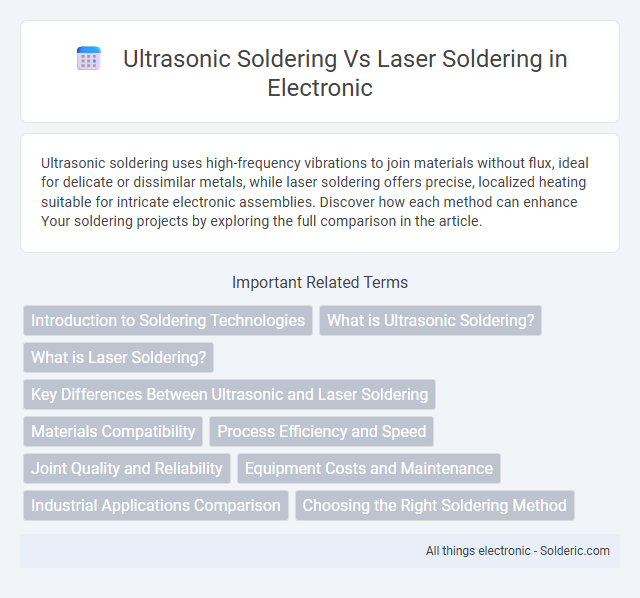Ultrasonic soldering uses high-frequency vibrations to join materials without flux, ideal for delicate or dissimilar metals, while laser soldering offers precise, localized heating suitable for intricate electronic assemblies. Discover how each method can enhance Your soldering projects by exploring the full comparison in the article.
Comparison Table
| Feature | Ultrasonic Soldering | Laser Soldering |
|---|---|---|
| Heat Source | High-frequency ultrasonic vibrations | Focused laser beam |
| Precision | Moderate, suitable for small to medium joints | High precision, ideal for micro soldering |
| Temperature Control | Indirect heating with minimal thermal damage | Direct heating with exact temperature control |
| Material Compatibility | Works on metals and some difficult-to-solder materials without flux | Effective on metals, semiconductors, and complex substrates |
| Flux Requirement | Generally flux-free or low flux usage | Usually requires minimal or no flux |
| Applications | Electronics assembly, medical devices, precision instruments | Microelectronics, aerospace, precision manufacturing |
| Equipment Cost | Lower initial cost, simpler setup | Higher initial cost, advanced technology |
| Processing Speed | Moderate speed | Faster processing with automation compatibility |
| Thermal Impact | Low thermal stress on components | Minimal thermal diffusion, localized heating |
Introduction to Soldering Technologies
Ultrasonic soldering uses high-frequency vibrations to create strong, flux-free bonds on difficult-to-solder materials like ceramics and glass, enhancing joint reliability in electronic and medical device manufacturing. Laser soldering employs a focused laser beam to deliver precise heat, enabling rapid, localized soldering with minimal thermal distortion, ideal for delicate components and fine-pitch assemblies. Understanding these advanced soldering technologies helps you choose the optimal method for improved efficiency and quality in complex manufacturing applications.
What is Ultrasonic Soldering?
Ultrasonic soldering is a specialized process that uses high-frequency ultrasonic vibrations to clean metal surfaces and facilitate solder wetting without the need for flux. This technique enables joining of difficult-to-solder materials, such as ceramics, glass, and certain metals, by breaking oxide layers and promoting adhesion at relatively low temperatures. Ultrasonic soldering enhances joint reliability and electrical conductivity in precision electronics and medical device manufacturing.
What is Laser Soldering?
Laser soldering utilizes a focused laser beam to precisely heat and join metal components without direct contact, enabling high accuracy and minimal thermal distortion. This technique is ideal for delicate or small-scale electronics, as the laser's controlled energy reduces the risk of damage compared to traditional soldering methods. Laser soldering offers rapid processing speeds and improved joint quality, making it a preferred choice in advanced manufacturing and microelectronics assembly.
Key Differences Between Ultrasonic and Laser Soldering
Ultrasonic soldering uses high-frequency vibrations to create strong, oxide-free joints without flux, ideal for bonding dissimilar metals and sensitive components. Laser soldering employs focused laser beams for precise, localized heating, resulting in minimal thermal stress and superior control over soldering quality. Your choice depends on application requirements, with ultrasonic favored for complex material combinations and laser preferred for high-precision electronic assembly.
Materials Compatibility
Ultrasonic soldering excels in joining dissimilar and sensitive materials such as glass, ceramics, and certain metals without flux, making it ideal for delicate electronic components and heat-sensitive substrates. Laser soldering provides precise, localized heating suitable for metals and hard-to-reach areas but may struggle with non-metallic or oxide-coated materials due to limited wetting capability. Your choice depends on the materials involved; ultrasonic soldering offers broader compatibility with diverse substrates, while laser soldering delivers high precision mainly for compatible metals.
Process Efficiency and Speed
Ultrasonic soldering provides high process efficiency by using ultrasonic vibrations to activate the solder, enabling rapid wetting and bonding with minimal thermal stress, which is ideal for joining difficult metals or dissimilar materials. Laser soldering offers superior speed and precision, utilizing focused laser beams for localized heating that reduces thermal damage and accelerates soldering cycles, making it suitable for intricate components and high-volume production. Both techniques enhance manufacturing throughput, but laser soldering generally delivers faster cycle times and greater automation potential in electronics assembly.
Joint Quality and Reliability
Ultrasonic soldering produces joints with strong metallurgical bonds and excellent wetting on difficult-to-solder materials, resulting in high reliability under thermal and mechanical stress. Laser soldering offers precise thermal control and minimal heat-affected zones, minimizing component damage and ensuring consistent joint quality in microelectronics applications. Both methods enhance joint reliability, but ultrasonic soldering is preferred for robust mechanical strength, while laser soldering excels in precision and fine-pitch assemblies.
Equipment Costs and Maintenance
Ultrasonic soldering equipment typically requires lower initial investment and less complex maintenance compared to laser soldering systems, which involve high-precision optical components and advanced cooling mechanisms. Maintenance for ultrasonic soldering mainly involves regular cleaning of transducers and soldering tips, while laser soldering demands more frequent calibration and servicing to ensure laser beam alignment and power stability. The higher upfront and operational costs of laser soldering can be justified in applications requiring precision and automation but may be prohibitive for general purpose soldering tasks.
Industrial Applications Comparison
Ultrasonic soldering excels in bonding dissimilar materials such as glass, ceramics, and metals in electronics manufacturing and medical device assembly, offering strong joints without flux. Laser soldering provides precise, localized heating ideal for microelectronics and aerospace components, minimizing thermal damage and improving repeatability in high-volume production. Your choice depends on material compatibility and production scale, where ultrasonic soldering suits complex assemblies, while laser soldering is preferred for high-precision industrial applications.
Choosing the Right Soldering Method
Ultrasonic soldering excels in joining dissimilar materials such as ceramics and glass to metals without flux, making it ideal for delicate electronics and precision components. Laser soldering offers precise, localized heat application suitable for microelectronics and high-volume manufacturing where minimal thermal impact and speed are crucial. Selecting the right soldering method depends on material compatibility, joint complexity, heat sensitivity, and production scale requirements.
Ultrasonic soldering vs laser soldering Infographic

 solderic.com
solderic.com